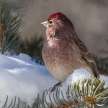
Evidently unique, and seldom seen, is Patagonian Tinamou, the southernmost form of the genus Tinamotis. It occurs mainly at altitudes of 200–800 metres, in steppe savanna, dry meadows and protected valleys with trees, and the species tends to be most widespread in areas where overgrazing has caused woody plants to overtake the grassland. Patagonian Tinamou, as its name implies, is limited to southern Argentina and neighbouring Chile. This tinamou is usually seen in small flocks throughout the year while in winter the flocks will reach as much as 30–40 individuals. Patagonian Tinamou is distinguished by being smaller than the more northerly Puna Tinamou, with some rufous on the primary, and black on the secondaries, although in any case there is little significant distinction. In winter some migration to coastal areas has been reported but more data is needed. Patagonian Tinamou feeds primarily on vegetable matter and is confirmed to be nesting in November and December, making the ground seemingly easy to scrap. Tinamous are stormy birds with short tail and long wings in the woodlands. The two species of Tinamotis are very large tinamous with a strongly shaved head and a rufous vent; they both have a very short body, and only three toes. Rufous cinnamon remigrated from Patagonian Tinamou. The genders are identical. Patagonian Tinamou is found mostly in southern Argentina, from southern Santa Cruz to the western Negro Valley. There are still some records from Aysén and Magallanes in neighbouring Chile but there are few if any recent records from Chile and their status is unknown. The diet of Patagonian Tinamou is not yet understood. This evidently feeds mostly on the leaves and stems of Pernetyia pumila, and on the seeds of Berberis buxifolia. There is no information about the vocal repertoire of Patagonian Tinamou. Vocalizations are generally described by the Patagonian Tinamou as "flute-like sounds" produced on the ground. It is a shy bird that can fly very quickly, concealed in bushes. If approached, it tries to hide on the ground but flies if pressed; members of a covey fly off in both directions; after the potential threat has vanished, the flock regains contact with their signal, which is similar to a whistle from the police. The birds sleep together as "black spots" in winter, while it snows. We dig a small depression into the field where they'd roost after the snow has gone down. As with its encounters with the climate, Patagonian Tinamou is relatively "plastic." It occurs in "open steppe with small and scattered shrubs growing on sandy or pebble soil, with rugged cushion plants and sparse tufts of coarse, ovine-grazed tussock grass spreading here and there," as well as in grassland steppes "in sheltered valleys with dense, small brush patches and in" open areas with scattered bushes. Usually avoids open fields, where strong winds prevail. The Patagonian Tinamou breeds from October until January. The nest is a simple garbage in sandy soil. The clutch consists of eight-to-two eggs, and maybe as many as 15. From what is known about the breeding system of other species, "the general rule for tinamous is sporadic polygyny for males and serial polyandry for females. Patagonian Tinamou may be single or in groups of up to 8 birds. Larger flocks of up to 30-40 persons may occur during winter months. Pozzi observed groups of up to 50 birds but this number is no longer reported. In Argentina, the Patagonian Tinamou is usually uncommon. Anecdotal accounts say figures are declining with severe snowfall despite harsh winters. This tinamou is considered particularly rare in Chile, with no recent reports, but its Chilean habitat is not well ornithologically surveyed. In the lack of evidence for any declines or significant threats, the human population is believed to be stable, and its IUCN Red List status is rated as a least concern.
About the Creator
MB
I am a bird aficionado and really enjoy spotting them them on hikes. I greatly appreciate the variety of birds cross North America and the world. They are amazing and intelligent creatures, each so unique and with a wonderful life.






Comments
There are no comments for this story
Be the first to respond and start the conversation.